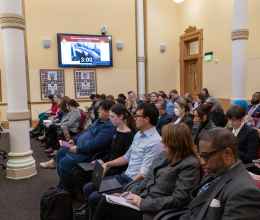
(From The Human Race and Other Sports)
By Christopher Brauchli, Human Race & Other Sports
As long as I count the votes, what are you going to do about it? — William Marcy Tweed, November 1871.
Recent events cause some to wonder whether the literacy tests that voters in some states were required to pass, before voting, from the early 1890s until the 1960s, are preferable to the methods used today to disenfranchise minority voters. Literacy tests were used so that those who were elected to high office could be sure that those who voted for them were literate and fully understood the issues and were not voting on the basis of what they saw in the popular media. A literacy test in Louisiana, for example, consisted of six questions that the prospective voter was given 10 minutes to answer. The instructions advised the test taker to “Be careful as one wrong answer denotes failure of the test.” One of the questions was :“Draw a line under the last word in this line.” Of course the real purpose of literacy tests was to keep the African American and other minority populations from voting. They succeeded. In 1940 only 3% of African Americans in the south were registered to vote.
Ever since passage of the 1965 Voting Rights Act and the disappearance of the literacy tests, Republicans have been fearful that African Americans and other minority voters would not support their candidates. That concern has grown as an increasing number of Hispanic immigrants have moved into the United States. Since literacy tests are no longer allowed, Republicans have come up with three new approaches to dilute the minority vote and, where possible, prevent minorities from voting.
One involves creating voting districts that place, for example, African American voters in highly concentrated districts so that their votes will not dilute votes in the adjoining mostly white districts. On October 7, 2014, a federal appeals court said Virginia’s newly drawn congressional map was unconstitutional because it packed blacks into the 3d District thus diminishing their influence in neighboring districts and violating the equal protection guaranteed by the 14th Amendment. On October 1, 2014, it was learned that the Florida Supreme Court would hear an appeal pertaining to a Florida Circuit judge’s approval of redrawn maps prepared by the Florida legislature that opponents believe prejudice minority voters.. On June 1, 2014, it was announced that the U.S. Supreme Court would hear two appeals from Alabama in which appellants argue that Republican legislators drew district lines that intentionally marginalized African American voters.
Redrawing districts is not the only substitute for literacy tests used by Republicans to marginalize the effect of increasingly enfranchised minorities. Reducing the number of days for voting is another. Ohio’s secretary of state reduced early voting for the November 2014 elections by one week and eliminated one day of Sunday voting, a day when black churches have traditionally taken congregants to the polls. He also eliminated the week during which voters were permitted to register and vote at the same time. The secretary of state explained that these changes were to reduce the opportunity for “fraud and abuse”. He did, however say that election fraud was “very rare.” On September 29, 2014, the U.S. Supreme Court said his changes were fine. That Court also approved North Carolina’s elimination of same-day voter registration and said a lower court was wrong when it ruled that refusal to count votes cast in the wrong precinct would harm minority-voting rights.
Voter ID laws are the third weapon of choice used by Republicans to disenfranchise minority voters while at the same time solving the non-existent problem of voter fraud. In Texas the legislature enacted what is considered the most restrictive voter ID law in the country. It addressed the problem exposed by two convictions for voter impersonation that took place in a 10-year period in Texas during which 20 million non-fraudulent votes were cast. Wisconsin, too, has enacted voter ID laws even though there is no evidence that voter fraud is a problem in that state. In a vigorous dissent from the majority opinion of the 7th U.S. Circuit Court of Appeals ruling in favor of Wisconsin’s new strict voter ID law, Judge Richard Posner said that the requirement that voters present photo IDs of themselves in order to vote “has placed an undue burden on the right to vote. . . . Some of the ‘evidence’ of voter-impersonation fraud is downright goofy, if not paranoid. . . . As there is no evidence that voter-impersonation fraud is a problem, how can the fact that a legislature says it’s a problem turn it into one? . . . . There is only one motivation for imposing burdens on voting that are ostensibly designed to discourage voter-impersonation fraud, if there is no actual danger of such fraud, and that is to discourage voting by persons likely to vote against the party responsible for imposing the burden.”
Judge Posner got it right. Republicans have it wrong. Perhaps they should see if, with the passage of many years since they were last used, literacy tests would once again pass muster. Here is one question they could use from the old Louisiana test: “Draw a line around the shortest word in this line.” They might even want to impose a requirement that all their candidates pass such a test. Many would not.

